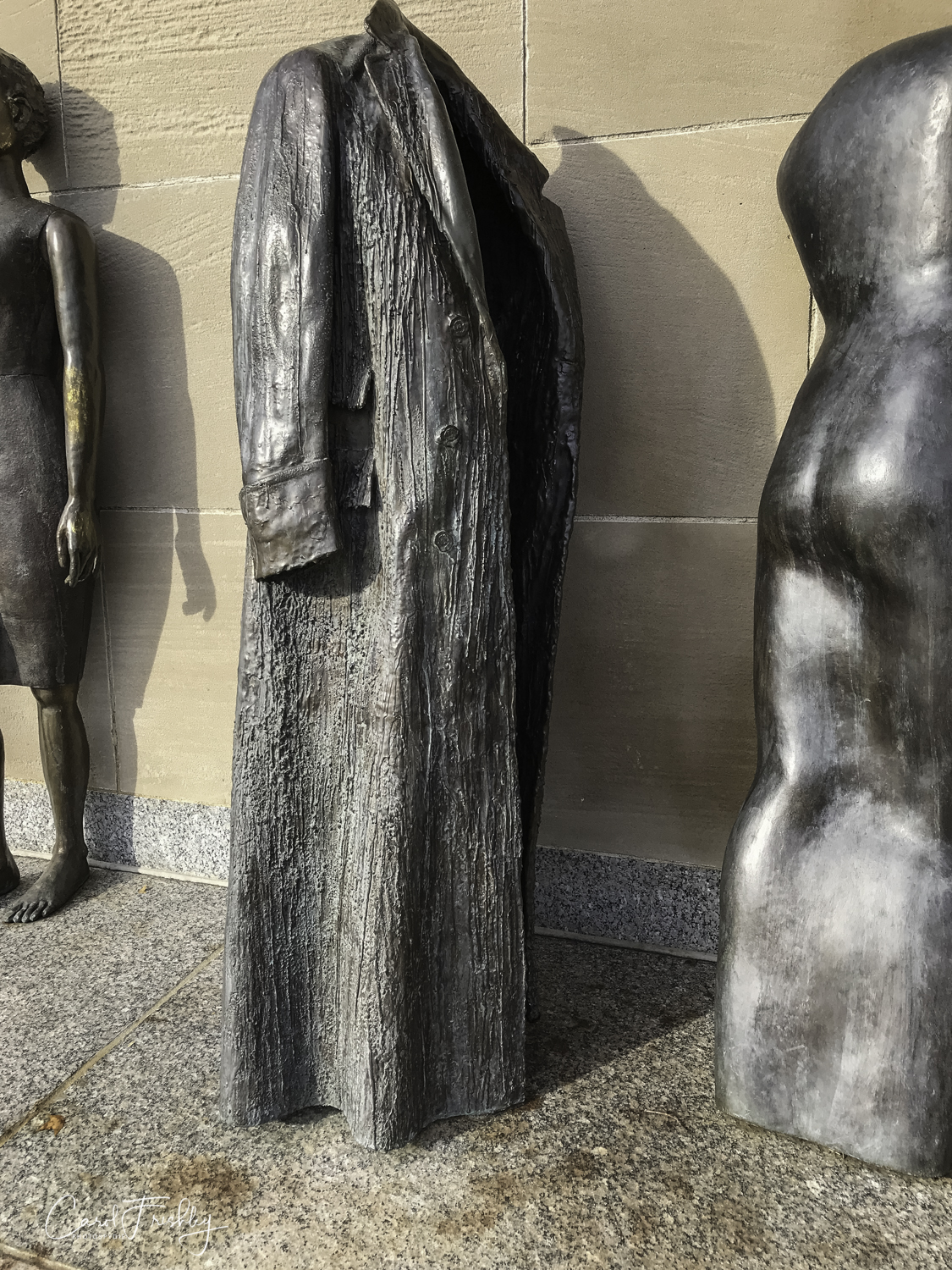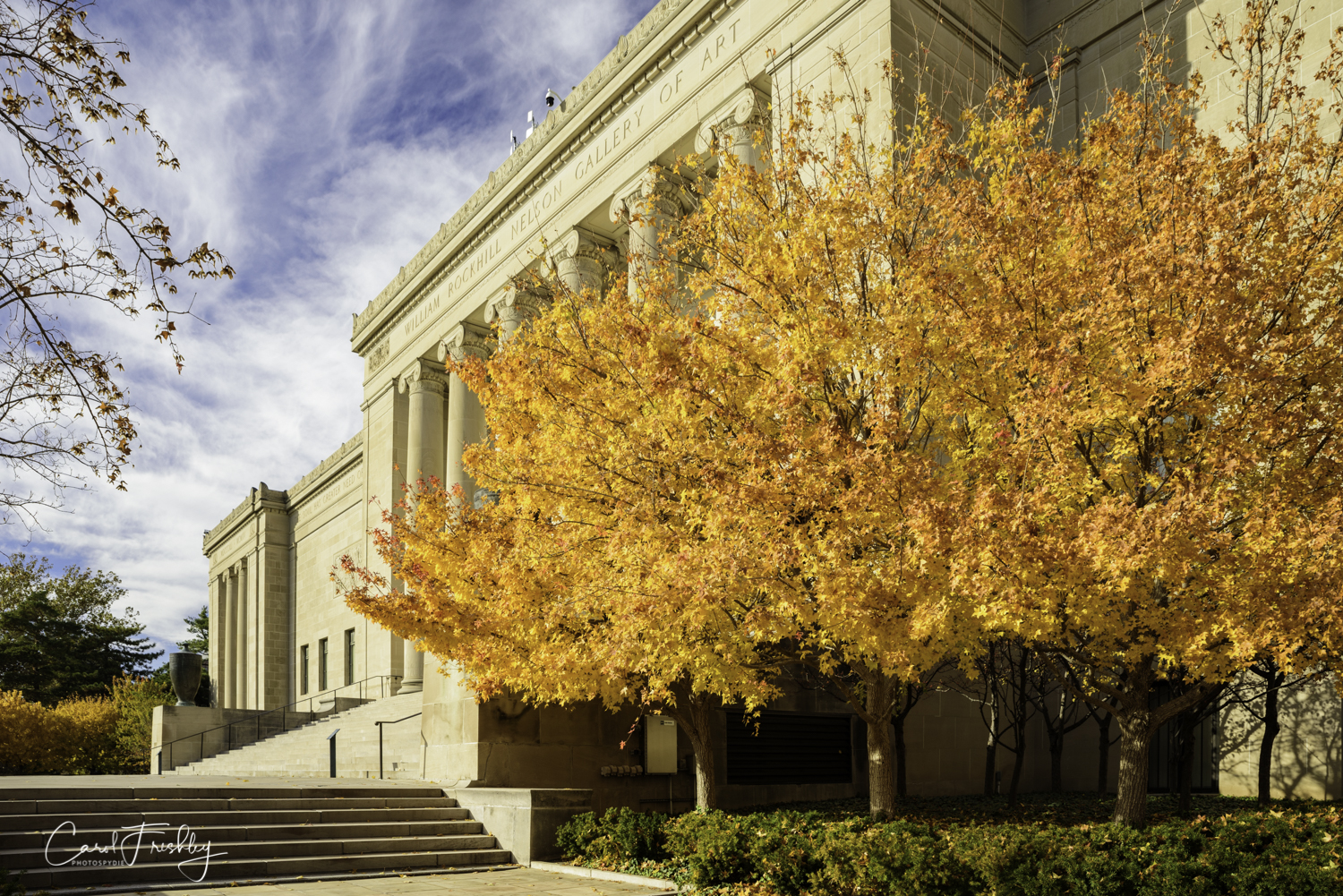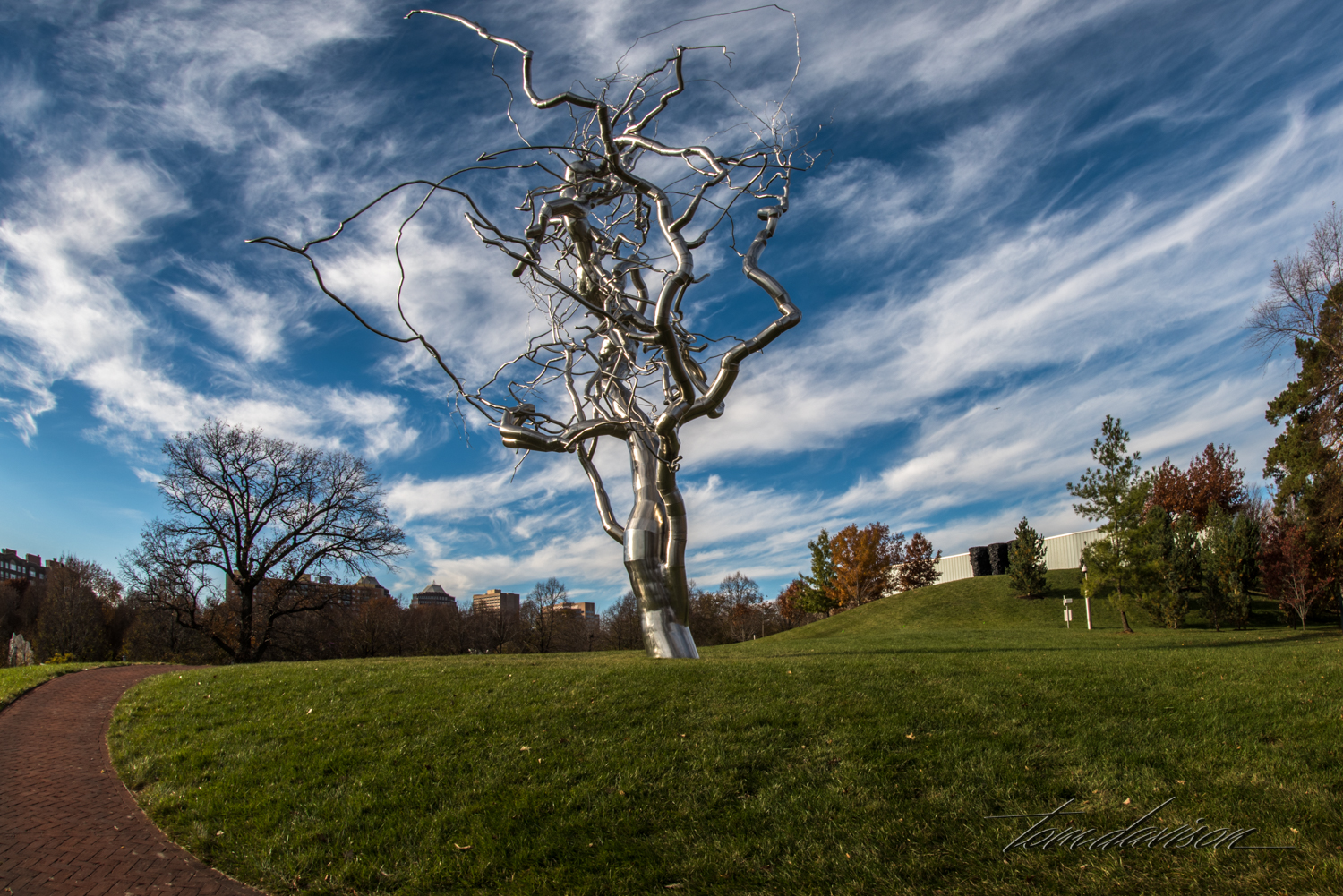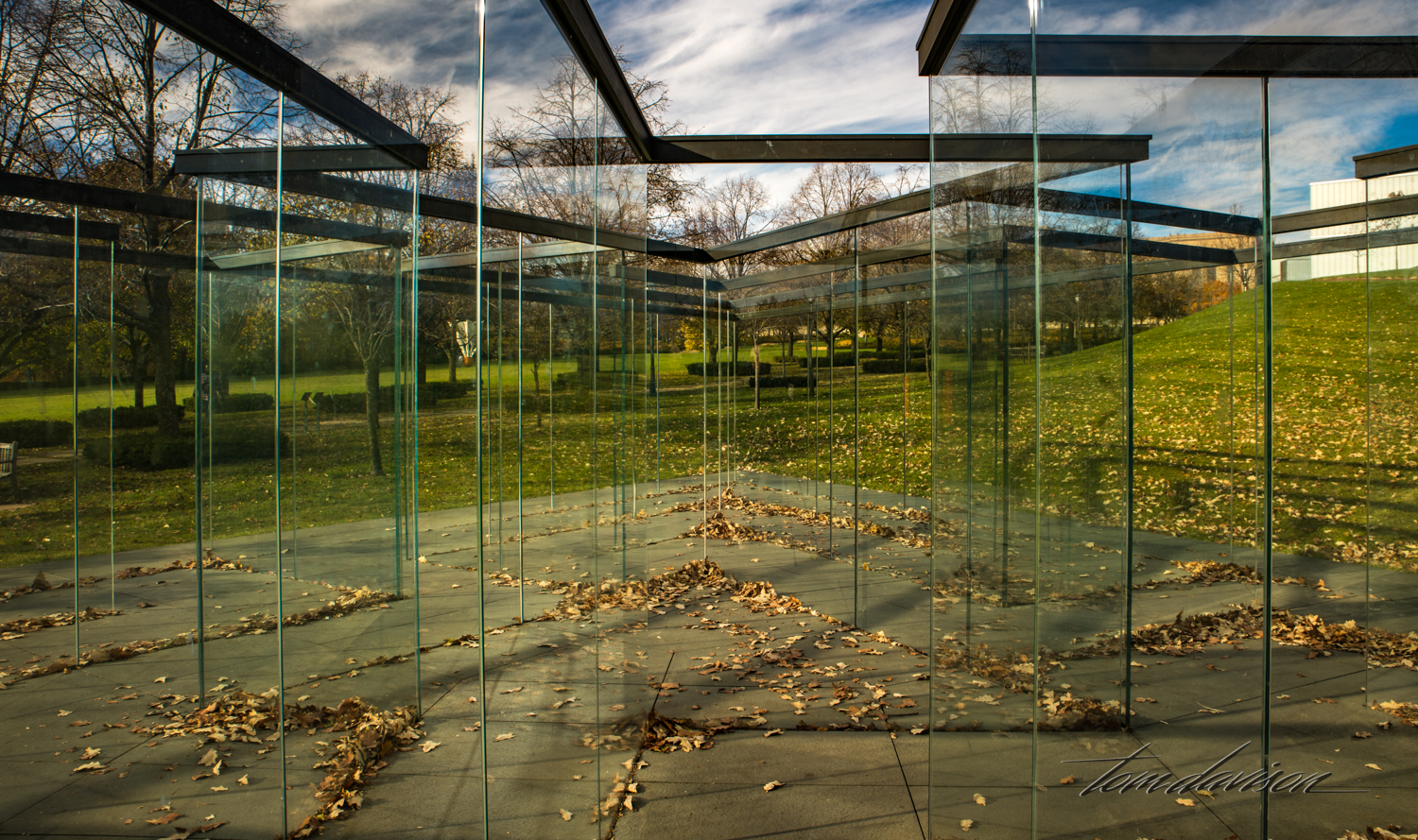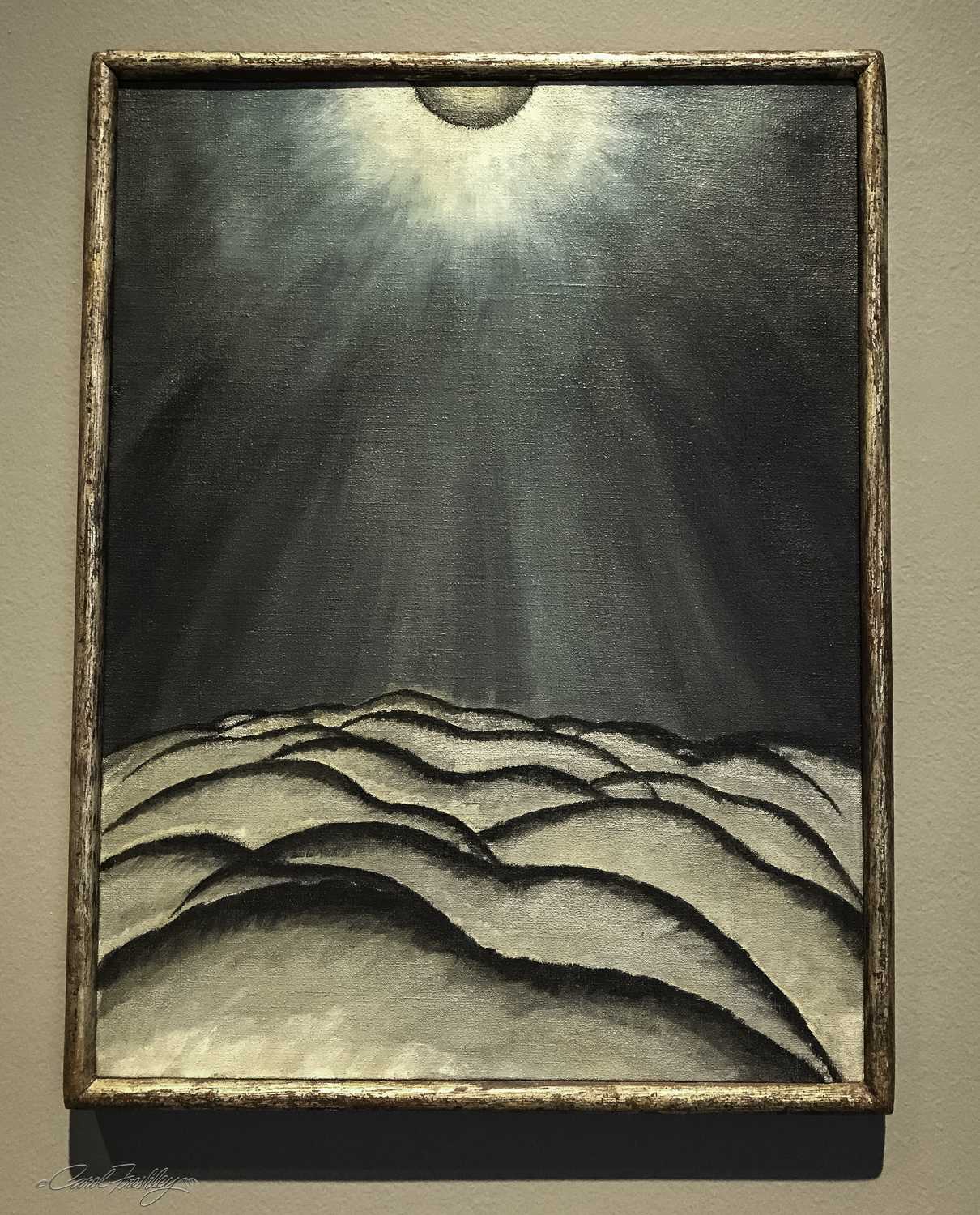The Nelson-Atkins Museum of Art ranks among the ten largest in the United States. It opened in 1993 and sits on 20 acres in south Kansas City. While the inner contents of the museum evoke a huge WOW factor, we found that the Donald J. Hall Sculpture Garden was equally impressive. It is home to our nation's largest collection of monumental bronze sculptures. We were gifted with a fabulous day of great weather and sky to walk paths covered with fallen leaves. Along the way we were able to appreciate some pretty great sculptures. Where possible, the notes posted next to each statue are reproduced here so that you may talk the same walk. Imagine the smells and light wind that followed us.
The grounds appear expansive and open. From this one spot you can see the Storage sculptures (standing along the wall this side of the people sitting on the bench), the Thinker (in the front grassy area) and one of four Shuttlecocks. The fall color had almost past peak in some areas and gone in other areas.
Auguste Rodin (1840-1917) was arguably the most celebrated sculptor of the 19th century. His innovative modeling technique and unconventional subject matter earned him praise as the greatest sculptor since Michelangelo. Rodin’s provocative sculptures are highly expressive of the human body, and he sought to convey such universal conditions as love, longing, reverie and despair. “Rodin’s capacity to capture the human spirit in all its nuances was unrivaled,” said Myers. “He was one of the first artists to consider fragments and partial figures to be complete works of art capable of expressing even the most complex thoughts and emotions. The Thinker, shown here, is one of about 28 full size castings. Rodin created The Thinker as part of commissioned work for The Gate of Hell. The first monumental bronze casting was shown in 1904.
Claes Oldenburg (1929-2009) and Coosje van Bruggen (1942-2009) were commissioned to create a sculpture to a 'signature' piece for the museum. They created the Shuttlecock. Each Shuttlecut is over 19 feet high and 15 feet in diameter. They are made of aluminum, fiberglass-reinforced plastic and paint. The story of how they came about is an interesting one. From the artist Claes Oldenburg himself, "Asked to create a large-scale project integrated into the setting of the museum, the team and I traveled to Kansas City, MO, in 1991, prepared to transform the vast imposing lawn that stretches before the massive neoclassical facade of the museum. While visiting the galleries soon after our arrival, Coosje was attracted to the headdresses worn by Native Americans in painting by Frederic Remington, which led to our initial concept of large feathers scattered over the lawn as if dropped by the wing of a huge passing bird. As we proceeded to research the site, we came across an aerial photograph of the museum grounds that reminded us of the layout of a tennis court. We imagined the museum building as a net, with balls distributed over the grounds. What if, as Coosje suggested, feathers were combined with the ball form to become a shuttlecock, a lyrical object with the ability to float, spin, fly, and land in many different ways?" As one might imagine, there was a lot of debate in the community about the proposal!!
This is Storage by Judith Shea, an American artist born in 1948. She "initially worked as a fashion designer. Later, she began making figurative sculptures, a radical idea in the avant-garde world of abstract art. Storage includes a hollow coat and dress, motifs that Shea uses frequently in her work. Shea stated, "They lean propped up against the wall essentially as if forgotten or stored. The truncated clothing forms provided an essence - no extremities, no movement; it was a way to express the essence of human presence." Cast in 1999 of bronze.
"Henry Moore's sculptures reflect his affinity for natural forms such as rocks, bones, mountains and the human figure. In Reclining Figure: Hand he simplifies the form of a reclining female figure, allowing her sensuous curves to echo those of a landscape. Moore preferred to see his work sited outdoors against the backdrop of sky and earth in order to underscore its relationship to nature." Henry Moore, English, 1898-1986, 1979 Bronze.
"This simple, geometric forms of Joel Shapiro's sculpture suggest the human body in motion. Untitled appears from certain views to have two upraised arms and one leg extended, as though taking a bow or preparing to do a cartwheel. Its open form activates the surrounding space and invite the viewer to strike a similar pose. Joel Shapiro, Amerian born 1941, cast in 1992 of bronze.
"Jacques Lipchitz's Return of the Prodigal Son retains a disciplined angularity derived from his early investigation of Cubism. It dates, however, from a later phase in his career, when he was occupied with organic forms and themes related to the human condition." This was his first interpretation of a biblical subjuct. American, born in Lithuania, 1891-1973, cast in 1931 of bronze.
This Auguste Renoir sculpture is entitled The Large Bather but is also known as The Washer Woman. Renoir did not take up the art of shiculpture until very late in life and this sculpture is modeled after his famous The Large Bathers paintings. I could not find an information note on this sculpture. I was fascinated by how my perception of the woman changed so much from walking around her.
"Peace on Earth incorporates themes and motifs that Jacques Lipchitz had been exploring for 20 years. The knotted masses at the base represent prima materia, the raw matter from which all things emerge. Progressing upward are depicted: the Lamb of God, angels, the Virgin Mary and ultimately the Holy Spirit in the traditional form of a dove. Peace on Earth is an optimistic work expressing the transformation of flesh into spirit. it broader underlying theme of metamorphosis occupied Lipchitz throughout his career. Cast in 1969 of bronze.
Henry Moore's Relief No. 1 "depicts the abstracted form of a woman standing with her weight on her left hip and her right knee jutting forward. Her head, undulating shoulders and breasts are implied by geometric cubic forms. Moore addressed this intentional ambiguity of form when he said that the 'non-logical, instinctive, subconscious part of [the viewer's] mind must 'play a part' in completing and understanding his work. While most of Moore's sculptures are meant to be seen in the round, this relief sculpture was intended to be viewed against a wall." Cast in 1959 of bronze.
Of course, this tree, entitled Ferment, reminded me of our visit to Crystal Bridges. Same sculptor, Roxy Paine, but a different tree. "Rising 56 feet into the air with a branching system spanning 35 feet, Roxy Paine's silvery sculpture acknowledges the power of human imagination and technological innovation. Its organic, tree-like form also speaks profoundly to the dendritic (branching) structures of nature - from our bodies (torso, arms, hands, fingers) to vascular and neurological systems to river deltas and erosion pattern to botanical branching. Ferment, one of more than 20 dendroid sculptures by Paine, investigates this complex interrelationship between nature and technology." This stainless steel sculpture was made in the artist's studio in New York and shipped to the museum in pieces. It too the artist and his team two weeks to join the pieces right on the lawn.
This is a 50-by-50-by-50 foot glass triangle with a maze of interior glass walls conceived by Robert Morris. Weighing in at more than 400 tons, the glass structure is almost unseen from a distance. "Throughout his career, Morris has resisted making art that is locked into a single static form. The Glass Labyrinth represents another twist on this idea: its appearance changes constantly with the movement of people within it and the flux of nature beyond"
This Sheep Piece, by Henry Moore is one of four full-sized bronze castings. The sculpture is massive! Moore wrote that the two forms were related, one being solid and passive, the other large but more active. The placement of the two pieces suggest warmth and protectiveness.
This is Large Torso Arch, another Henry Moore sculpture.
Another Henry Moore sculpture, Reclining Connected Forms, 1969 of bronze. "Although abstract, this sculpture is an example of Henry Moore's basic themes, that of mother and child. The configuration of the sculpture suggests a maternal figure containing a childlike form within her protective embrace.
"Large Totem Head is a bulbous, concave form divided into two halves by a vertical plane. Frontal and iconic, it expresses a kind of elegant grandeur. Large Totem Head evokes Moore's interest in the art of ancient and non-European cultures. The sculpture shares with Egyptian and African art its emphasis on stasis, reductive form and symmetry. Cast in bronze by Henry Moore in 1981.
"Ursula von Rydingsvard (American of Polish descent, born 1942) sculpts intuitively and without drawings or models to guide her process. She creates each sculpture directly from a mental image that evolves as she works. The roughly hewn, steeply vertical surfaces of Three Bowls bring to mind weathered, rocky cliffs. Von Rydingsvard reinforces this impression by saturating the wood with black graphite, which silvers as it ages. The artist stated, "I am drawn tot hat part of the world where man-made walls erode in a way where there is no longer a strict line between that which man has made and that which nature has made." Made of cedar and graphite in 1990.
"Tony Craig, born in 1949, is one of Great Britain's most esteemed artists. His sculpture, Ferryman, may refer to the operator of a ferry boat, to the fluid body of water or to the molecular structure of matter itself. Its amorphous form extrudes and wraps in upon itself in an endless flow of energy to create a playful dialogue between interior and exterior spaces." It was created in 1997 of bronze.
Turbo by Tony Cragg (English born 1949), refers to an energy-generating form like a spinning top or a turbine engine. Tony Cragg explores the tilted form at rest, but its impression is one of intense dynamism. While Turbo is cast in bronze (2001), lending it a machined quality, its form is irregular, as if comprised of discs whirling out of phase. This idiosyncratic play between randomness and logical order characterizes much of Cragg's work.
In the distance you can see the George Segal composition entitled Rush Hour.
This is George Segal's Rush Hour, cast in 1995 of bronze. "This composition of anonymous figures evokes the deep isolation that can occur even when we are surrounded by others. The bronze sculptures are made from casts formed by applying plaster-dipped gauze directly onto the faces and clothed bodies of the models, who were friends and neighbors of the artist. Segal says that each figural form is a distinct psychological portrait." Segal was an American sculptor (1924-2000).
The island in the middle of the reflecting pool is actually a statue! It is Walter de Maria's One Sun / 34 Moons, a bronze and stainless steel, neon illuminated sculpture that "lives within time and timelessness. The gold-leaf rectangular Sun shines during the day, constantly reflecting the dance of actual sunlight and clouds overhead. At night, the 34 Moons, encircled by silvery white neon, emit a mysterious glow. Related to the cycles of day and night, the seasons and the heavens, One Sun / 34 Moons takes on cosmic and mythic proportions."
Mere hits of several of the moons below the water are captured. At night, these moons light up.
Notice the sculptures across the lawn? They are shown in closer detail below.
Magdalena Abakanowicz's Standing Figures are instantly identifiable by their stark imagery. The haunting power of these headless, standing figures invites many interpretations and the artist welcomes this approach. Could they be awaiting final judgement? Do they suggest war victims? Are they primordial beings in silent communication.? Each figure is individually cast from a burlap-lined body mold."
Mark di Suvero's sculpture, Rumi "celebrates industrial constuction through its use of steel I-beams and the orange paint of San Francisco's Golden Gate Bridge. The work is named for Jala al-Din Rumi, the 13th century Persian poet and spiritual leader whose writings inspired Sufism, a mystical for of Islam. Some adherents of this religious order worship God in trance-like dances and are often called Whirling Dervishes. The dynamic form of the sculpture suggests their ecstatic movement." Sculpture created in 1991.
Unfortunately, we did not even get to walk around to the left side of the Sculpture Park. We have left many great opportunities for next time. Perhaps we shall return in the spring . . .







